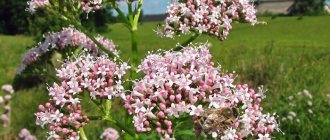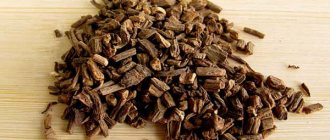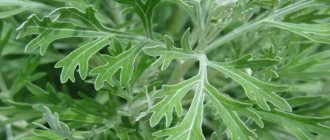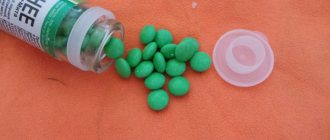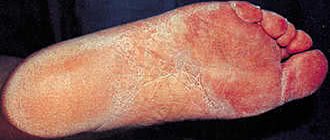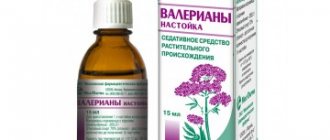Everyone knows valerian extract, or in common people - “valerian”. As soon as you get a little excited and grab your heart, you can immediately hear the advice to “drink some valerian.” And indeed, the excitement will subside, the heartbeat will return to normal, and your soul will feel lighter. This simple medicine is found in almost every home, but it is surprising that few people know what the plant itself looks like, although it is found everywhere. Valerian officinalis is a herbaceous perennial that can be grown in open ground and in your own apothecary garden. Planting and care are not difficult, but there are some growing features, especially for medicinal purposes, that you should be aware of.
It is interesting that in pharmaceuticals the concept of “valerian” is a collective one, including several varieties of the plant, since different types of this crop have healing properties.
general description
Valerian is a herbaceous perennial of the Honeysuckle family. It has many other names, of which the most common are “goatee”, “cat moun (or grass)”, averyan, fever root, shaking grass (help with “shaking”, falling sickness).
Valerian is a fairly tall plant; it can often grow taller than human height. It has a vertical short and thick rhizome, overgrown with numerous additional thin roots up to 20 cm long. The stem is erect, weakly branched, hollow inside. The imparipinnate leaves are arranged oppositely, petiolate in the lower part of the stem and sessile in the upper part. Valerian blooms in June and continues to bloom for 2-2.5 months. The flowers are small, fragrant, attracting bees, collected in a corymbose inflorescence. After flowering, a small achene of an elongated ovoid shape ripens on the fistula stem.
Valerian leaves are great for adding to tea.
Traditional recipes for treatment with valerian
First, let’s figure out how to properly prepare the herb so that you can subsequently prepare preparations from it at home. After digging up the roots, shake off the soil and rinse them under the tap. Then cut the thickest specimens as you wish - lengthwise or crosswise - into 3-4 parts.
Carefully lay them out on paper in a dry and well-ventilated area. The raw material is ready when the roots break when bent. Next, you should sort through the roots and throw away any spoiled ones. Can be stored for three years in a cool place out of direct sunlight. It is important that cats cannot get in there.
The most commonly used plant-based medications are Corvalol, anhisedin, valocormid and simply thick valerian extract. You can prepare the following medicines at home:
- Infusion. 1 tbsp. crushed dry root should be poured with hot water in a thermos overnight. In case of increased excitability, drink the resulting drink three times a day, 1/3 cup.
- Tincture. Pour valerian root, for example, with vodka or 70% alcohol in a ratio of 1 to 5. Leave for a week, then strain and store in a warm place. Take 15 drops per day.
- Decoction. Grind valerian root into pieces no more than 3 mm in diameter, add 300 ml of water at normal room temperature, boil for half an hour in a water bath and filter. Drink half a glass of tridzhi per day.
- Bath. For epilepsy, as well as for bathing a hyperactive child, you can make a bath of valerian. Pour 100 grams of root with water for 10 hours, strain and add to the bath.
- Juice. May help with excessive excitability of the nervous system. The juice should be squeezed out of the roots at the very beginning of spring. Take a spoon three times a day along with honey (the last time at night).
- Remedy for gastritis. Take equal amounts of valerian, orange peel, wacht and peppermint. Pour a little of this mixture into 200 ml of boiling water and wrap it in a warm towel for 30 minutes. After this time, filter the infusion and drink several large sips 3-4 times a day.
Some varieties
Valerian includes more than 250 species, of which at least 30 grow in our country. Most of the varieties have certain healing properties.
Valerian officinalis
The most famous and used in folk medicine is a tall species. It has a straight hollow stem, branched at the top, and a short rhizome, no longer than 4 cm. In many countries, including Russia, it is grown on an industrial scale for pharmaceutical use, although it is not the only medicinal variety. The leaves are dissected, the flowers are small, collected in a large paniculate (less often thread-like) inflorescence. It has good decorative properties when planted in groups. For medicinal purposes, the rhizome is dug up in the second year of life.
Valerian recumbent
A dwarf variety that can be grown as a ground cover. Forms a curtain no more than 7 cm in height. The flowers are small, light, pink-lilac, collected in dense inflorescences up to 3 cm in volume. Tolerates shading well, but in the sun it produces compact plantings with higher decorative qualities. It grows well on its own.
Mountain valerian
Medium-sized variety up to half a meter high. Petiolate large oval leaves form a basal rosette. The panicles of the inflorescences are lush, consisting of many small buds of pale pink color. Unlike the previous species, it will prefer places with partial lighting and is moisture-loving. Flowering is early, in the first two months of summer.
Valerian stone-loving
A low-growing species, excellent for decorating rock gardens and rockeries. Stems are slightly curved, ascending, low. The total planting height does not exceed 20 cm. The leaves are long-petiolate, pubescent, pink inflorescences, racemose. Easily tolerates cultivation on poor rocky soils. When planting in rocky crevices or under stones (for example, in rockeries), you should choose places on the eastern side.
Valerian red
A representative of the subfamily, belonging to another close genus, Centranthus, and is still rarely found in Russian gardens. It grows up to a meter in height, blooms fragrantly and for a long time with small snow-white or crimson flowers, collected in lush dome-shaped inflorescences. In addition to significant growth, the plant tends to grow in width. The most popular varieties for gardens are Coccineus and Albiflorus.
Economic importance and application
Valerian officinalis is used in everyday life and in many industries. For example:
- In everyday life: fresh flowers of the plant are used to steam jugs to prevent milk from souring in them
- In pharmaceuticals - for the manufacture of drugs
- In animal husbandry - for treating animals from spasmodic colic
- In scientific medicine - for the treatment of diseases of various etiologies
- In the tobacco industry - as a flavoring agent in the production of Havana cigars and Turkish tobacco
- In the alcoholic beverage industry - in the production of essences, liqueurs, tinctures
Growing Valerian
Planting and care in open ground are simple and not difficult, but some aspects depend on the chosen variety. In particular, the method of reproduction, which will be discussed below.
Choosing a landing site
The plant loves moist but light soils. It can be loam or sandy loam, but cat grass will grow and bloom best on black soil or soils similar in fertility. With regard to illumination, the type and purpose of planting should be taken into account. If you are planning on being decorative, it is better to choose more illuminated areas. The humidity of the area may be high; valerian is demanding of moisture.
When planning planting, you should take into account the proximity to other crops, since goatee can grow up to 2 m and shade other beds.
Watering
What is desirable is not so much abundant as regular watering. The plant needs moisture not only for flowering and the formation of seeds and rhizomes, but also for the accumulation of important substances in it - primarily essential oils.
Where does it grow
Valerian herb grows in Europe, Asia, South and North America. In Russia it grows everywhere, except in the Far North and desert zones. Loves swampy areas, wet forests and bushes, meadows, banks of rivers, lakes and streams.
Valerian officinalis medicinal properties
Reproduction
Some types of valerian reproduce exclusively by seeds (they do not have stolons), but ready-made seedlings can be found for sale in specialized retail outlets and nurseries. If you want to grow this plant in your garden, the best option would be a non-seed method, since it has several serious disadvantages:
- To grow a full-fledged marketable medicinal rhizome from seeds, it will take three growing seasons.
- The seeds have poor germination and continue to quickly lose it as they are stored.
- It is advisable to sow seeds immediately after collecting them, in winter, or to provide them with artificial stratification under strict temperature and time conditions, which is quite difficult and troublesome.
- Valerian seedlings necessarily need picking, which adds trouble and time.
Meadow valerian (victorious) is free from all the disadvantages associated with seed propagation, since its roots produce stolons - shoots of the rhizome intended for natural vegetative propagation.
Self-seeding
Valerian is prone to self-seeding. On the one hand, this solves the issue of propagation of the planting, on the other hand, it heavily clogs the area. In addition, if you let the seeds ripen “on the bush,” the rhizome will be fairly depleted. Therefore, when planting for the purpose of obtaining medicinal raw materials, it is recommended to pick off the inflorescences at least immediately after they begin to fade, or better yet, cut off the flower stalks. By the way, they can stand perfectly in a vase.
Reproduction by stolons
You can dig up stolons together with the preparation of rhizomes, waiting until late autumn. The tops of the dug up bushes are cut off, after which the rhizome and roots are washed, and the stolons are separated from them. There can be 5-8 of them on one plant. Due to their white color they are clearly distinguishable. In addition, they are significantly thicker than the lateral cord-like roots. They should have a green bud at the end. They can either have their own roots or be deprived of them, this does not affect survival rate.
The resulting planting material is planted in the garden bed immediately after separation from the mother bush. As a last resort, it is possible to postpone the event for 1-2 weeks. In this case, you need to store them in a cool place, taking measures to ensure that they do not dry out. To do this, you can put them in a bucket (without water) and cover them with cardboard, or you can simply dig them in the garden.
Stolons are planted at a distance of at least 0.5 m from each other, completely buried in the ground. In the spring they will sprout and can be replanted if necessary. The survival rate of such planting material is almost 100%.
Pharmacological properties
According to pharmacognosy, valerian officinalis has a number of positive effects on the human body, due to which it is used for medical purposes. Pharmacological actions are as follows:
- Calming effect. Perhaps this is the most famous property of this plant. If you ask a person what he would drink “for his nerves,” he will almost certainly answer – drops of valerian. Indeed, the herb helps calm the central nervous system and relieve muscle spasms. This in turn allows you to cope with nervous disorders, sleep problems, high blood pressure, and heart attacks.
- Normalization of the digestive process. Valerian-based products help relax smooth muscles, relieve spasms, and improve peristalsis. Therefore, the plant helps well with problems with the gastrointestinal tract, for example, with frequent constipation and pain in the gall bladder.
- Improving a woman's condition during menstruation. Many girls do not tolerate menstruation well, they experience pressure surges, headaches, and increased irritability. Valerian helps to cope with these manifestations.
- Allergic reaction. The herb calms the nervous system in case of neurodermatitis, which helps reduce the amount of skin rashes and the intensity of itching.
Valerian has a multifaceted effect on the body
. Valerian is harmless and does not harm human health. But you still need to use it in the dosages recommended by the instructions, as side effects are possible.
Watch out, cats!
Everyone knows how cats treat valerian. The growing plant, especially its root, also has an attractive scent. However, as long as it grows peacefully in the ground, cats usually do not bother it much. The danger lies in digging the root. If pieces of it remain on the ground, their smell attracts cats from all over the area. They like to fall out in the ground in an empty garden bed, and if you plant something else on it, it can be destroyed. It is recommended to dig up the rhizome carefully and entirely, leaving as few roots as possible in the ground.
Experienced herbal gardeners cover the bed with valerian with a metal or polymer mesh like a cage, which must be well secured at the edges.
Interesting Facts
- The smell of valerian spread over the surface is very popular with domestic cats. It not only attracts their attention, but literally drives them crazy. The animal begins to roll on the floor or wrap circles around an object that emits the smell of valerian. In some cases, it may be noted that the cat looks as if after taking narcotic drugs. However, not all breeds are susceptible to this influence. It has been proven that small kittens are completely indifferent to the smell of valerian. It is also interesting that some cat breeds are resistant to the smell of valerian. For example, valerian tincture has no effect on Siamese cats
- According to ancient legend, a certain Panteley the healer went into the forest early in the morning to collect medicinal herbs. When he came out into a forest clearing, he was stunned by the beauty that had opened up to him: strange plants grew among the bushes, gray in the morning light. It was as if there were a lot of soft pink lights glowing in the dark hanging in the air. There was a feeling as if thin, light streams were rising straight from the ground and gently swaying in the morning cool. Panteley cautiously entered the clearing and, after thinking a little, began to dig up the ground in search of the roots of the mysterious plant. And then he was surprised to discover that the more he collected roots of strange flowers, the better and more at ease he felt. When the bag was filled to the brim, at the same time the healer’s soul was filled with joy and joy. On the way home, Panteley distributed amazing roots to people he met along the way, and they, inhaling the aroma of the plant, immediately began to experience an extraordinary surge of vigor and vitality. This is how the herb valerian was discovered
Preparation of medicinal raw materials
The harvesting of valerian roots and rhizomes should begin in the second year, when they accumulate the maximum amount of essential oil, valeric acid, tannins and other useful elements. It is best to do this in the fall after the end of the growing season. In two years, the rhizomes grow in weight up to 200-300g.
Freshly dug material is thoroughly washed under running water and dried in a good draft and sun for 2-3 days. After this, the roots are removed into the shade and dried there completely. During this time, they turn from light and without a characteristic odor to dark brown and acquire a familiar aroma. It is recommended to cut rhizomes that are too thick lengthwise to facilitate and speed up the process. The easiest way is to immediately cut them with garden shears for ease of further use.
Care must be taken to ensure that the roots are laid out to dry out of the reach of cats.
The slower the drying process, the stronger and more persistent the characteristic odor of medicinal raw materials will be.
Similar species
When harvesting valerian officinalis, you should pay special attention to species similar in appearance to it, which often grow nearby. Some of them are poisonous and, therefore, if used incorrectly and carelessly, can cause harm to health. Similar types of valerian officinalis are:
- medicinal swallowtail – Vincetoxicum hirundinaria (Alexitoxicon officinale (Moench) St. Lager) – poisonous;
- Lobel's hellebore - Veratrum lobelianum Bernh - poisonous;
- hemp sapling – Eupatorium cannabinum – poisonous;
- meadowsweet (meadowsweet) – Filipendula ulmaria Maxim.
In addition, there are valerians, although they look similar to medicinal valerian, but do not have medicinal properties. First of all, this is whole-leaved valerian (Valeriana simplicifolia Kabath), etc. They can be distinguished by the absence of a characteristic recognizable aroma of rhizomes.
